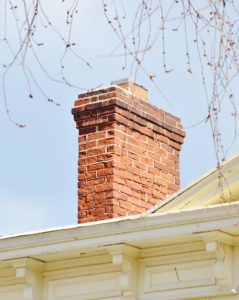While many of us consider summer to be our favorite season, there is one thing guaranteed to make spending time outside less enjoyable – insects. From mosquitos and flys to bees and wasps, insects can run the gamut from helpful to the environment to benign to downright malicious.
Unfortunately, it can sometimes be difficult to tell the difference between friendly insects and their more malevolent counterparts. One insect that suffers from a bad reputation is the mud dauber wasp. While they are significantly less aggressive than other members of the wasp and hornet families, their penchant for building nests on the side of chimneys brings them to the attention of homeowners and chimney sweeps alike.
All about mud daubers
 Mud dauber wasps are long, lean, yellow and black wasps that are found throughout the United States. They are named after their unique behavior around water, mud dauber wasps can often be found on the edges of ponds and puddles collecting mud to build their nests.
Mud dauber wasps are long, lean, yellow and black wasps that are found throughout the United States. They are named after their unique behavior around water, mud dauber wasps can often be found on the edges of ponds and puddles collecting mud to build their nests.
Mud dauber wasps are solitary and significantly less aggressive than other wasps. They rarely sting humans and are known instead for eating a variety of insects, which they collect and take back to their nests. One of their favorite types of prey is spiders, making them a natural solution to controlling outdoor pest populations.
Mud dauber nests and chimneys
Mud daubers are known to collect mud to build their unique nests. The rounded, tube-like nests of mud daubers are often found on the exteriors of buildings – and are often on the sides of chimneys. Because of this, many homeowners turn to their chimney sweeps to rid of mud dauber nests.
Whether they appear individually or in a row, mud dauber nests are always the result of a single wasp. There is no need to worry that a swarm of wasps has taken up residence on the exterior of your chimney; in fact, a mud dauber wasp can be a helpful ally in controlling the population of other insects around your home!
Removing mud dauber nests
There is little chance of a mud dauber nest damaging the underlying masonry. However, the nests should still be removed with caution. One of the easiest methods of nest removal is simply hitting it with a broom handle; the dried mud of the nest should simply fall away from the masonry. If this does not work, a small metal scraper can be used to gently remove the nest.
While small amounts of water can be used to help loosen a mud dauber nest, it is not recommended to remove the nest with a power washer. The power washer can easily knock the nest loose, but it can also damage the underlying masonry. The extreme water pressure of a power washer can cause more damage to the mortar and bricks than a mud dauber nest could.
Have more questions? Contact us today!
If you find a mud dauber building a nest on the side of your chimney, there is little cause for concern. These solitary wasps might look intimidating, but they rarely sting, help control insect populations, and have nests that do not damage the underlying masonry. For more information on mud dauber wasps and how they can affect your chimney, contact Jack Pixley Sweeps today!
